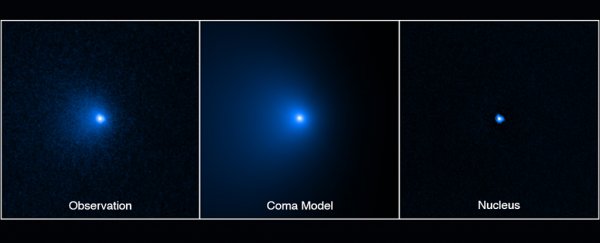The largest comet ever discovered has been traveling towards the Sun for over 1 million years, and its gigantic scale shines a light on the mysterious objects that make up one of the biggest structures in our Solar System.
In a new study, astronomers used the Hubble Space Telescope to confirm that the solid center of the giant comet C/2014 UN271 (Bernardinelli-Bernstein) is the largest comet nucleus ever detected. It measures a staggering 50 times larger than most known comets, at almost 140 kilometers wide (about 85 miles).
However, that freakishly large size – or rather the apparent weirdness of it – might say more about us and our limited conception of comets than it does about anything else.
C/2014 UN271 hails from the Oort Cloud: a gigantic, spherical scattering of icy objects proposed to surround the Sun at the deepest and most distant stretches of our Solar System (so far away, in fact, it's thought to extend at least a quarter of the way towards the next nearest star system, Alpha Centauri).
Sounds pretty big, right? It is, theoretically speaking. However, the Oort Cloud is so far away and so difficult to detect, it's basically a gigantic hypothetical mystery, even though astronomers consider it to be one of the largest structures in our Solar System.
Once in a while, though, something emerges out of this enigmatic mass, gravitationally lured towards the Sun from the remoteness of the cosmic hinterlands.
 Comet nucleus size comparison. (NASA/ESA/Zena Levy, STScI)
Comet nucleus size comparison. (NASA/ESA/Zena Levy, STScI)
C/2014 UN271 is one such object, and it stands to tell us much about the existence of the frozen 'pristine' masses that make up the Oort Cloud. These are thought to have formed early in the inner Solar System, before being flung out to its outermost fringes by the gravitational effects of giant planets like Jupiter and Saturn.
"This comet is literally the tip of the iceberg for many thousands of comets that are too faint to see in the more distant parts of the Solar System," says astronomer David Jewitt from UCLA.
"We've always suspected this comet had to be big because it is so bright at such a large distance. Now we confirm it is."
In the new analysis, Jewitt and fellow researchers, led by first author Man-To Hui from the Macau University of Science and Technology, calculated the size of C/2014 UN271 in the highest resolution yet. They built upon previous estimates by using Hubble observations and modeling to isolate the nucleus from the comet's coma – the long tail of ice sublimating into gasses in the comet's wake.
"We confirm that C/2014 UN271 is the largest long-period comet ever detected," the team writes in their new paper.
 (NASA/ESA/Man-To Hui, Macau University of Science and Technology/David Jewitt, UCLA/Alyssa Pagan, STScI)
(NASA/ESA/Man-To Hui, Macau University of Science and Technology/David Jewitt, UCLA/Alyssa Pagan, STScI)
Above: Sequence showing a Hubble image of the comet, its modeled coma, and the isolated nucleus.
The discovery of C/2014 UN271 was announced last year, after it was found hidden in a body of observational data captured by the Dark Energy Survey between 2014 and 2018. Subsequent follow-up analyses revealed C/2014 UN271 was actually picked up as early as 2010.
Yet even that early glimpse doesn't begin to encompass the incredible length of the comet's journey. It follows an approximately 3-million-year-long elliptical orbit around the Sun, the shape of which means it has been slowly approaching the Sun for significantly over 1 million years.
It is due to reach its closest approach to the Sun – known as perihelion – in 2031, at which point Bernardinelli-Bernstein will still remain about 1 billion miles from the Sun, before arcing back outwards on its ovoid trajectory.
That means we've got almost a decade of improving observational opportunities ahead of us, to learn more about C/2014 UN271 and its ilk as the comet draws closer, before it slips off quietly into the dark once more.
The findings are reported in The Astrophysical Journal Letters.
